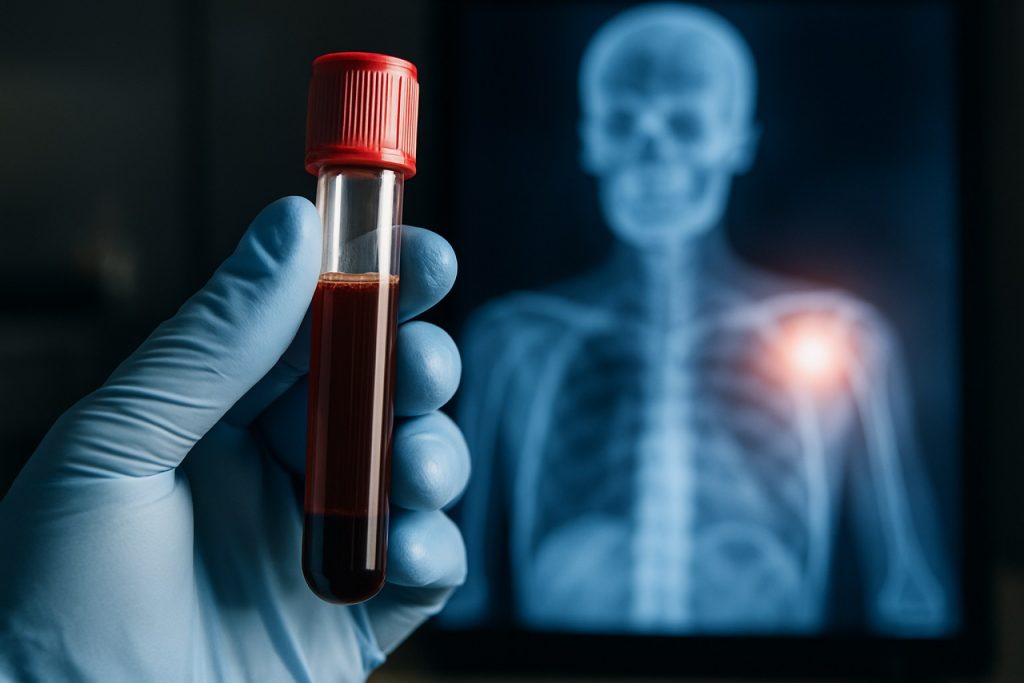
- Liquid biopsies use a simple blood draw to detect circulating tumor DNA (ctDNA), enabling less invasive cancer detection compared to traditional biopsies.
- New approaches focus on detecting DNA methylation patterns—epigenetic changes unique to cancer—that improve sensitivity, even when DNA fragments are scarce.
- Advanced technologies allow analysis of both genetic and methylation signals from a single plasma sample, preserving crucial material and boosting diagnostic accuracy.
- Methylation-guided assays may allow for earlier detection, monitoring, and identification of multiple cancer types, including hard-to-diagnose forms like prostate cancer.
- The main challenge is scaling these epigenetic liquid biopsies for widespread, routine clinical use, offering hope for improved survival rates through early intervention.
Under the sharp glare of laboratory lights, scientists unravel secrets once hidden deep within our cells—clues that cancer leaves behind, like shadows in our DNA. Now, a quiet revolution is brewing in oncology, promising a future where detecting cancer might be as simple—and gentle—as rolling up your sleeve for a routine blood draw.
A liquid biopsy delivers that possibility, drawing a small vial of blood to probe for the faintest whispers of disease. Unlike traditional tissue biopsies, which can require surgery and risk, liquid biopsies slip inconspicuously into standard check-ups and repeat visits. Yet, in these early stages, the enemy is elusive. Tumors shed only tiny fragments of their DNA—circulating tumor DNA (ctDNA)—into the bloodstream, often too faint to spot with standard approaches. The challenge has fueled a race to devise tests with almost uncanny sensitivity.
Researchers are betting on epigenetic markers, with a special focus on DNA methylation—a chemical tag dotting the genome like strategic beacons. Cancer doesn’t just mutate; it scrambles these methylation patterns, creating new signatures that set malignancies apart from healthy tissue. The abundance of methylation sites offers a tantalizing advantage: higher odds of detection, even when DNA fragments are scarce.
Picture the next era of cancer care, where a single blood draw could sift through these methylation patterns and flag multiple cancer types at their earliest, most treatable moments. Leading scientists across Europe and the UK now fine-tune methods that read both genetic and methylation data from the same precious plasma sample, addressing a core technical hurdle: every microliter of blood counts, and splitting it for separate tests wastes irreplaceable material.
Enhanced technologies, such as specialized target enrichment systems, preserve these fragile methylation markers without the harsh amplification steps that erase epigenetic clues. These tools double the data extracted from every sample, boosting the potential for earlier, more accurate diagnosis—and, crucially, allowing clinicians not just to detect cancer, but to monitor its progress, analyze how it responds to therapy, and determine its tissue of origin.
For patients, especially those facing daunting diseases like prostate cancer, this could signal a gentler, more precise future. The hope is real: with methylation-guided assays, the faint biochemical footprints of tumors stand less chance of evading detection.
Pragmatic clinical scientists focus on translating these high-tech workflows into fast, reliable diagnostics that can be implemented in real clinics, not just research settings. The challenge now is scale—making protocols robust enough to serve a global population, and simple enough for regular use. The stakes could not be higher. Early detection, after all, remains one of medicine’s most effective weapons against cancer.
As these methylation-based tests inch closer to approval and widespread adoption, the horizon brightens. A world where cancer announces itself long before symptoms appear beckons—a world where survival rates climb, and hope outpaces fear.
Key takeaway: By decoding the unique epigenetic patterns lingering in the blood, scientists are poised to revolutionize cancer screening—offering new avenues for detection, personalized treatment, and the promise of catching cancer before it can hide.
For ongoing breakthroughs and expert-backed information on health and life sciences, explore Nature and American Cancer Society.
Could a Simple Blood Test Be the Future of Cancer Detection? What Experts Aren’t Telling You About Liquid Biopsy Breakthroughs!
Revolutionizing Cancer Detection: The Untapped Potential of Liquid Biopsy and DNA Methylation Markers
Liquid biopsy stands as one of the most promising frontiers in cancer screening and early detection. While the source article highlighted the core technology and the hope it represents, there are numerous additional facts, implications, and expert insights worthy of closer attention. Here’s what you really need to know to stay ahead of the curve.
—
What Are Liquid Biopsies and Why Do They Matter?
Liquid biopsies are noninvasive tests that analyze biomarkers—such as circulating tumor DNA (ctDNA), exosomes, and circulating tumor cells—in blood or other body fluids. Their key advantage over conventional biopsies is the ability to repeatedly sample and monitor cancer without discomfort or risk associated with surgical procedures.
Additional Facts:
– FDA Approvals: Certain liquid biopsy tests (such as Guardant360 CDx) are already approved by the FDA for specific indications, such as non-small cell lung cancer ([source](https://www.fda.gov)).
– Beyond Blood: Liquid biopsies can also use urine, saliva, or cerebrospinal fluid depending on the cancer type ([source](https://www.cancer.gov)).
– Minimal Residual Disease (MRD) Detection: Liquid biopsies can identify cancer recurrences at a molecular level even before imaging does.
—
How Do DNA Methylation Markers Improve Detection?
Most solid tumors shed only minuscule amounts of DNA into the bloodstream, making detection challenging. Methylation markers—chemical modifications to the DNA—offer a denser source of diagnostic information.
Why Methylation?
– High Abundance: There are millions of methylation sites across the genome, compared to fewer mutation sites. This means methylation-based tests can achieve higher sensitivity.
– Cancer Specificity: Certain methylation patterns are unique to specific cancer types, aiding both in detection and identifying tumor origin.
– Therapy Monitoring: Shifts in methylation markers can signal how a tumor is responding to treatment—enabling real-time therapy adjustments.
—
Real-World Use Cases & Clinical Impact
– Multi-Cancer Early Detection (MCED): Companies like GRAIL are developing tests (e.g., Galleri) that screen for over 50 types of cancer from a single blood draw, focusing heavily on methylation profiling ([source](https://www.grail.com)).
– Personalized Treatment: Liquid biopsies can provide actionable data for guiding targeted therapies, especially where traditional biopsies are unfeasible due to tumor location or patient condition.
– Disease Tracking: Oncologists increasingly employ ctDNA and methylation data to monitor remission status and catch relapses early.
—
Market Trends & Forecasts
– Rapid Market Growth: The global liquid biopsy market is projected to surpass $6 billion by 2030, with a CAGR of over 23% (Grand View Research).
– Adoption Drivers: Rising cancer incidence, demand for minimally invasive testing, and advances in next-gen sequencing fuel expansion.
– Barriers: High test costs, reimbursement challenges, and lack of standardization remain hurdles for widespread clinical use.
—
Features, Specs & Pricing
| Aspect | Liquid Biopsy (Current) | Traditional Biopsy |
|———————-|————————–|—————————–|
| Invasiveness | Minimally invasive | Surgical/invasive |
| Repeatable | Yes (multiple times) | No (limited) |
| Specificity/Sensitivity | Improving with methylation | High (tissue specific) |
| Time to Results | 1–7 days (varies) | Up to 2 weeks |
| Cost | $500–$5,000 (varies) | $2,000–$10,000 |
Costs refer to US market averages and may vary.
—
How-To Steps: Getting a Liquid Biopsy
For Patients:
1. Consult Your Oncologist: Ask if a liquid biopsy is appropriate for your cancer type or stage.
2. Blood Draw at Clinic: The test typically requires just one tube of blood.
3. Wait for Lab Analysis: Results are usually available within a week.
4. Discuss Next Steps: Your medical team will interpret results and advise on treatment or surveillance.
—
Pros & Cons of Liquid Biopsy
Pros:
– Less risk/faster recovery than surgical biopsy
– Enables frequent monitoring
– Can detect cancer before symptoms appear
– May identify multiple cancer types at once
Cons:
– Sensitivity still limited for very early cancers
– Cost and insurance coverage vary
– Not a full substitute for tissue biopsy (yet)
—
Controversies & Limitations
– False Positives/Negatives: Some tests may detect benign conditions or miss early-stage cancers entirely. Ongoing studies seek to improve accuracy.
– Data Interpretation: Not all detected mutations or methylation changes are clinically actionable (source: Nature).
– Implementation: Clinical guidelines for how to act on liquid biopsy results are still under development.
—
Security, Privacy & Sustainability
– Data Security: Genomic data is highly sensitive; major providers must comply with HIPAA and GDPR regulations.
– Sustainability: As blood-based tests reduce surgical biopsies, they may decrease medical waste and lower healthcare carbon footprint over time.
—
FAQs: What Readers Need to Know
How accurate are current liquid biopsy tests for cancer screening?
Accuracy is improving: The specificity of some MCED tests exceeds 99%, though sensitivity (especially in early-stage tumors) varies by cancer type (GRAIL, 2023).
Is a liquid biopsy covered by insurance?
Coverage is expanding but not universal; check with your provider and health plan ([source](https://www.cancer.org)).
Can a liquid biopsy replace all tissue biopsies?
Not yet. Pathological assessment and tissue-based testing remain the gold standard for definitive diagnosis and treatment planning.
Are there risks?
Risks are minimal—comparable to routine blood draws.
—
Actionable Recommendations & Quick Tips
– Patients: If you have a personal or family history of cancer, ask your doctor about new blood-based screening options as part of your regular check-ups.
– Clinicians: Stay current with clinical trial data and evolving guidelines (visit American Cancer Society for updates).
– Researchers: Focus on refining methylation analysis algorithms to improve early-stage detection sensitivity.
– Healthcare Systems: Invest in infrastructure for broad, equitable access to noninvasive cancer screening.
—
Final Insights & Predictions
Liquid biopsy with methylation analysis could soon shift the paradigm of cancer care—from reactive to proactive. Expect rapid evolution as big data, AI, and machine learning are integrated into analysis pipelines, further driving accuracy and adoption rates. A future in which your yearly check-up screens quietly and painlessly for dozens of tumor types is within sight—making cancer a disease we catch, treat, and beat earlier than ever.
For deeper dives into emerging oncology research, visit Nature and American Cancer Society. Stay informed—early knowledge could be lifesaving!



